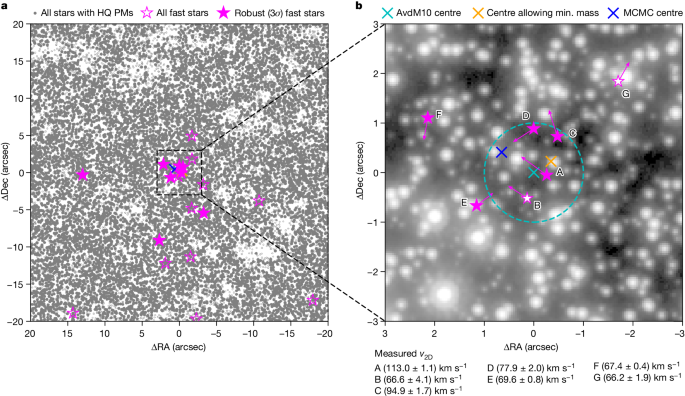2024-07-11 マックス・プランク研究所
<関連情報>
- https://www.mpg.de/22157737/black-hole-in-omega-centauri?c=2249
- https://www.nature.com/articles/s41586-024-07511-z
- https://arxiv.org/abs/2404.03722
オメガ・ケンタウリの中質量ブラックホール周辺の高速移動する星々 Fast-moving stars around an intermediate-mass black hole in ω Centauri
Maximilian Häberle,Nadine Neumayer,Anil Seth,Andrea Bellini,Mattia Libralato,Holger Baumgardt,Matthew Whitaker,Antoine Dumont,Mayte Alfaro-Cuello,Jay Anderson,Callie Clontz,Nikolay Kacharov,Sebastian Kamann,Anja Feldmeier-Krause,Antonino Milone,Maria Selina Nitschai,Renuka Pechetti & Glenn van de Ven
Nature Published:10 July 2024
DOI:https://doi.org/10.1038/s41586-024-07511-z

Abstract
Black holes have been found over a wide range of masses, from stellar remnants with masses of 5–150 solar masses (M☉), to those found at the centres of galaxies with M > 105M☉. However, only a few debated candidate black holes exist between 150M☉ and 105M☉. Determining the population of these intermediate-mass black holes is an important step towards understanding supermassive black hole formation in the early universe1,2. Several studies have claimed the detection of a central black hole in ω Centauri, the most massive globular cluster of the Milky Way3,4,5. However, these studies have been questioned because of the possible mass contribution of stellar mass black holes, their sensitivity to the cluster centre and the lack of fast-moving stars above the escape velocity6,7,8,9. Here we report the observations of seven fast-moving stars in the central 3 arcsec (0.08 pc) of ω Centauri. The velocities of the fast-moving stars are significantly higher than the expected central escape velocity of the star cluster, so their presence can be explained only by being bound to a massive black hole. From the velocities alone, we can infer a firm lower limit of the black hole mass of about 8,200M☉, making this a good case for an intermediate-mass black hole in the local universe.
oMEGACat II — オメガ・ケンタウリにある140万個の恒星の測光と固有運動、そして天球平面上での自転 oMEGACat II — Photometry and proper motions for 1.4 million stars in Omega Centauri and its rotation in the plane of the sky
Maximilian Häberle, Nadine Neumayer, Andrea Bellini, Mattia Libralato, Callie Clontz, Anil C. Seth, Maria Selina Nitschai, Sebastian Kamann, Mayte Alfaro-Cuello, Jay Anderson, Stefan Dreizler, Anja Feldmeier-Krause, Nikolay Kacharov, Marilyn Latour, Antonino Milone, Renuka Pechetti, Glenn van de Ven, Karina Voggel
arXiv Submitted on 4 Apr 2024
DOI:https://doi.org/10.48550/arXiv.2404.03722

Abstract
Omega Centauri (ω Cen) is the most massive globular cluster of the Milky Way. It is thought to be the nucleus of an accreted dwarf galaxy because of its high mass and its complex stellar populations. To decipher its formation history and study its dynamics, we created the most comprehensive kinematic catalog for its inner region, by analyzing both archival and new Hubble Space Telescope (HST) data. Our catalog contains 1 395 781 proper-motion measurements out to the half-light radius of the cluster (∼5.0′) and down to mF625W≈25. The typical baseline for our proper-motion measurements is 20 years, leading to a median 1D proper motion precision of ∼11 μas yr−1 for stars with mF625W≈18 mag, with even better precision (∼6.6 μas yr−1) achieved in the extensively observed centermost (r<1.5′) region. In addition to our astrometric measurements, we also obtained precise HST photometry in seven filters spanning from the ultraviolet to the near-infrared. This allows detailed color-magnitude-diagram studies and to separate the multiple stellar populations of the cluster. In this work, we describe the data reduction used to obtain both the photometric and the proper-motion measurements. We also illustrate the creation and the content of our catalog, which is made publicly available. Finally, we present measurements of the plane-of-sky rotation of ω Cen in the previously unprobed inner few arcminutes and a precise measurement of the inclination i=(43.6±1.5)∘.



